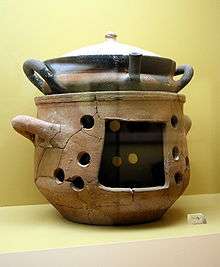Casserole


A casserole (French: diminutive of casse, from Provençal cassa "pan"[1]) is a large, deep pan used both in the oven and as a serving vessel. The word is also used for the food cooked and served in such a vessel, with the cookware itself called a casserole dish or casserole pan. "Casserole" should not be confused with the word "cacerola" which is Spanish for "cooking pot".
In the United States and continental Europe casseroles usually consist of pieces of meat (such as chicken) or fish (such as tuna), various chopped vegetables, a starchy binder such as flour, rice, potato or pasta, and often a crunchy or cheesy topping.[2] Liquids are released from the meat and vegetables during cooking, and further liquid in the form of stock, wine, beer (for example lapin à la Gueuze), gin, cider, or vegetable juice may be added when the dish is assembled. Casseroles are usually cooked slowly in the oven, often uncovered. They may be served as a main course or a side dish, and may be served in the vessel in which they were cooked.
In the United Kingdom, the Republic of Ireland, Australia, and New Zealand, a casserole is named after its dish, rather than its contents. Casseroles in these countries are very similar to stews. The difference is that once the meat and vegetables are browned on top of the stove, they are then cooked in liquid in the oven in a closed dish, producing meat that is tender and juicy, from long slow cooking. The heat is indirect, so there is less chance of burning.
Examples of casserole include ragout, Lancashire hotpot, cassoulet, tajine, moussaka, shepherd's pie, timballo, and carbonnade. A distinction can be made between casseroles and stews: stewing is a cooking process whereby heat is applied to the bottom of the cooking vessel (typically over a fire or on a stove), whereas casserole is generally baked in an oven, where heat circulates all around the cooking vessel. Casseroles may be cooked covered or uncovered, while braises are typically covered to prevent evaporation.
History

In 1866, Elmire Jolicoeur,[3] a French Canadian immigrant, invented the precursor of the modern casserole in Berlin, New Hampshire.[4] The casseroles we know today are a relatively modern invention.[5] Early casserole recipes consisted of rice that was pounded, pressed, and filled with a savoury mixture of meats such as chicken or sweetmeats. Some time around the 1870s this sense of casserole seems to have slipped into its current sense.[6] Cooking in earthenware containers has always been common in most nations, but the idea of casserole cooking as a one-dish meal became popular in the United States in the twentieth century, especially in the 1950s when new forms of lightweight metal and glass cookware appeared on the market. By the 1970s casseroles took on a less-than sophisticated image.[7]
See also
References
- ↑ Online Etymology Dictionary, Entry: Casserole, retrieved 19 September 2015
- ↑ Yoon, Howard. "Nouveau Casseroles". Kitchen Window, National Public Radio, March 4, 2009. Retrieved 4 December 2009.
- ↑ Rachel Nolan. "The many-layered story of the casserole, a longtime staple of American cuisine". Archived from the original on 2013-01-05. Retrieved July 30, 2012.
- ↑ jovinacooksitalian. "Italian Casseroles and braises". Retrieved October 24, 2012.
- ↑ "Food Timeline: Casseroles". www.foodtimeline.org. March 28, 2009. Retrieved April 15, 2009.
- ↑ An A–Z of Food & Drink, John Ayto, Oxford University Press, 2002, pp. 60–61.
- ↑ The Encyclopedia of American Food and Drink, John F. Mariani Lebhar-Friedman, 1999, p. 59.
Further reading
- Wright, C.A. (2011). Bake Until Bubbly: The Ultimate Casserole Cookbook. Houghton Mifflin Harcourt. p. pt19. ISBN 978-0-544-17748-2. – History of the casserole
External links
| Wikimedia Commons has media related to Casseroles. |
| Look up casserole in Wiktionary, the free dictionary. |